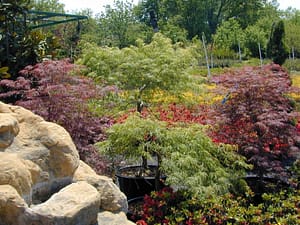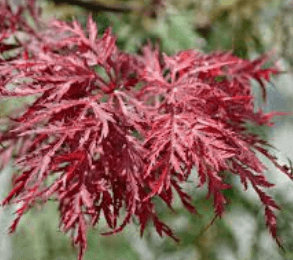Japanese Maples In The Landscape
Japanese maples are a beautiful addition to any garden. With their stunning red or green color and delicate shape, Japanese maple trees add an air of elegance to any garden. Japanese Maple trees are beautiful, versatile trees that can be grown in both small and large yards.
These plants are popular for their colorful foliage, which comes in shades of red, orange, yellow and purple. Japanese Maple trees grow well almost anywhere there is enough space for them to spread out their roots.
Japanese Maples are a special and unique species of tree that have been cultivated for thousands of years in Japan. The Japanese grew them for their beauty, as well as their usefulness as a food source, medicine, and dye.
Nowadays, they're grown all over the world in private gardens and public parks. But it's easy to get confused with all the different types of Japanese Maples out there! So let's learn more about this beautiful species of tree!
The first thing to know about Japanese Maples is that they are deciduous. That means that they lose their leaves every year when the weather gets cold. The leaves of a Japanese Maple will turn brilliant shades of yellow, orange, and red in the autumn, then fall off in the winter.
However, it can be difficult to properly identify and care for this type of tree. In this post, we'll cover some basics that will get you started!
Japanese Maple Identification
The first step in caring for your Japanese maple tree is correctly identifying it. There are a few ways to tell if the tree you have is a Japanese maple: look at the leaves, check the bark texture, and dig around in the soil.
To identify Japanese Maples (Acer palmatum), look for their palmate leaves, typically with 5-9 lobes, deep serrations, and brilliant fall colors. Laceleaf varieties (dissectum) have more delicate, feathery leaves. They are generally small trees or shrubs with a rounded crown.
Japanese maple bark varies depending on the specific cultivar and age of the tree. Generally, the bark is smooth and thin, with a grayish-brown color that often develops an attractive patina as the tree matures.
On younger trees, the bark is typically light gray or reddish-brown and may have subtle striations or lenticels. As the tree ages, the bark can develop a more textured appearance, with small plates or scales forming on the trunk and larger branches.
Some Japanese maple varieties, particularly those in the Acer palmatum group, may exhibit exfoliating bark that peels away in thin layers, revealing lighter-colored inner bark beneath. This characteristic adds visual interest to the tree, especially during winter months when the leaves have fallen.



Planting Japanese Maples
To correctly plant a Japanese maple, follow these steps:
Choose the Right Location
Select a spot with morning sun and afternoon shade or filtered light. Ensure the soil is well-drained and slightly acidic. Do not plant where it will receive a lot of wind.
Prepare the Hole
Dig a hole that is twice the width of the root ball but not deeper
Amend the Soil (if necessary)
Mix organic compost with the native soil, especially if your soil is heavy clay or sandy. They prefer slightly acidic soil, so adding some peat most will help them thrive. I once went to a professionally landscaped backyard with about 20 very large Japanese Maples that were dying.
I took soil tests around several trees. The pH was 8.4 and there was a high salt content which we found to be from watering with well water. Before the landscapers planted $30,000 worth of trees, they should have amended the soil.
Position the Tree
Place the root ball in the hole and ensure the top is slightly above ground level. Stake the trees so that they do not move in the wind. Be sure any ties that you use are the type that will break off as the tree grows. Set an alarm to remind you to take off the stakes in a few months.
Backfill and Water
Backfill the hole with the amended soil, tamp it down gently, and then water it thoroughly. Apply a 2-3 inch layer of mulch around the tree, keeping it away from the trunk. Water the tree deeply after planting and continue to water regularly, especially during the first growing season.
Once you've identified the tree as a Japanese maple, you'll want to pick out a good spot for it in your yard—the best place is somewhere with full shade so that it doesn't get too hot during summer months unless you live in the Northern States. The leaves are delicate and thin, so keep them out of the wind also. Wind will tatter the leaves and cause them to dry out.
How to Prune Japanese Maples
Once you've got everything set up, here's how you prune your Japanese maple: start by removing any dead or diseased branches first (they're usually at least half-dead already), then go ahead and trim off anything growing downward from the main trunk—this will help open up space under where they were growing so more light can reach those leaves above.
Trim any branches that are crossing and rubbing against each other, or will be soon. The buds on Maples are opposite, so wherever you prune the limb, there are 2 buds that will break open and begin to grow. You can remove one of the buds if you want the new limb to go a specific direction. This is how you can fill in a hole or make sure the limbs are not heading inward.
Always prune any limbs befow the graft. They will be original to the rootstock plant, not the top grafted variety.
Japanese Maple Issues
Japanese maples are susceptible to various insect pests and diseases. If they are planted in the wrong environment, they will have more issues.
Insects
Common insect problems include scale insects, spider mites, and Japanese beetles. Scale insects appear as small bumps on branches and leaves, sucking sap and weakening the tree. Spider mites cause stippling on leaves and can lead to leaf drop in severe infestations. Japanese beetles feed on foliage, leaving behind skeletonized leaves.
Diseases
Diseases that affect Japanese maples include verticillium wilt, leaf spot, and root rot. Verticillium wilt is a fungal disease that causes branches to die suddenly, often on one side of the tree. Leaf spot diseases create discolored areas on leaves, potentially leading to defoliation. Root rot, caused by various fungi, can occur in poorly drained soils and results in overall tree decline.
Canker diseases and leaf scorch are additional concerns for Japanese maples. Cankers appear as sunken areas on branches or trunks, potentially girdling and killing affected parts. Leaf scorch, often caused by environmental stress, results in browning leaf edges and can be exacerbated by hot, dry conditions or excessive wind exposure.
Choosing A Variety
These trees come in many different varieties, and the one for you depends on what you want your tree to look like and where you are going to plant it.
The first thing to consider is if you want a grafted or seed-grown plant. Both have their pros and cons, but generally speaking, grafted plants tend to be more expensive and will produce a more uniform plant over time. Seed-grown plants are less expensive, but they may take longer to reach maturity.
To determine if a Japanese Maple is grafted, inspect the base of the trunk. A visible bump or change in the bark color and texture just above the rootstock usually indicates a graft union.
When choosing which Japanese maple is right for you, you will want to consider the color of your leaves in spring and fall as well as their size when fully grown so that they fit with the rest of your landscape design.
The next step would then be deciding where to grow your new tree - preferably not too close together!
Some popular grafted varieties include:
- Bloodgood Japanese Maple
- Red Dragon Japanese Maple
- Crimson Queen Japanese Maple
- Coral Bark Japanese Maple
- Orangeola Japanese Maple
- Tamukeyama Japanese Maple
They all grow well in USDA Hardiness Zones 5 to 8. If your zone is hotter than that (zones 9-11), it's best to find a spot for your maple that gets afternoon shade.
When you get your tree delivered, it should be in one of two forms: grafted or seedling grown. Grafting means the tree was grown from a cutting or bud from a tree variety that you are buying. This means that it will look exactly like the mother plant from the graft up. It will have the root system of the original seed grown tree that the graft or bud was grafted on.
Conclusion
Japanese Maples are a great choice for landscapes. They add beauty and increase the value of the landscape. If they are planted in the correct way, in the correct location, they will live for many years. They are low maintenance trees that can be showstoppers that add color most of the year. If you choose a Coral Bark Japanese Maple, it will add year-around color. Enjoy your trees, and keep them watered.
Want to Watch This Article As a Video?
Below is the video version of this article. The trees pictured in the video are 90% japanese maples but there are a few clips with other maples shown.


